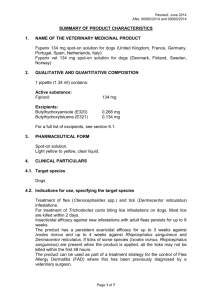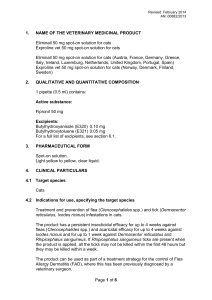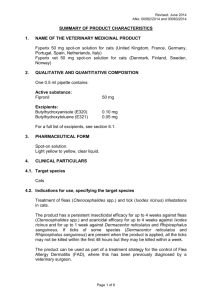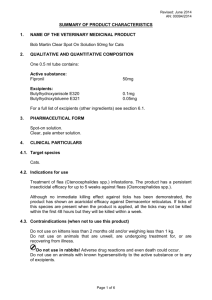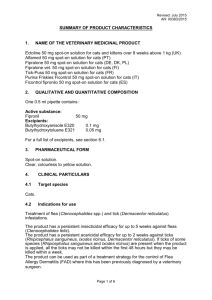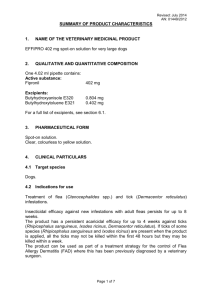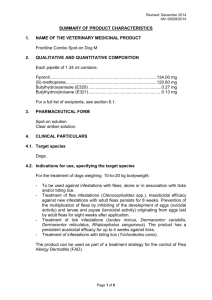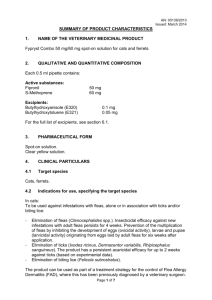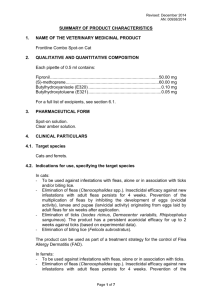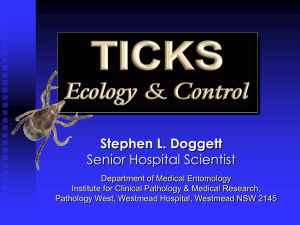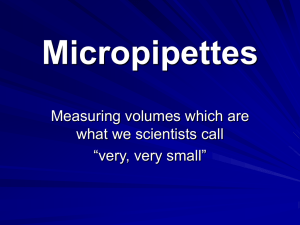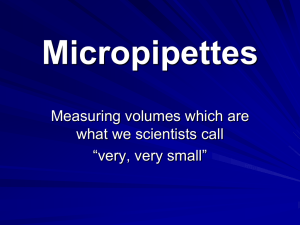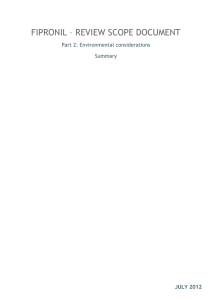Revised: February 2015 AN: 01415/2014 SUMMARY OF PRODUCT
advertisement
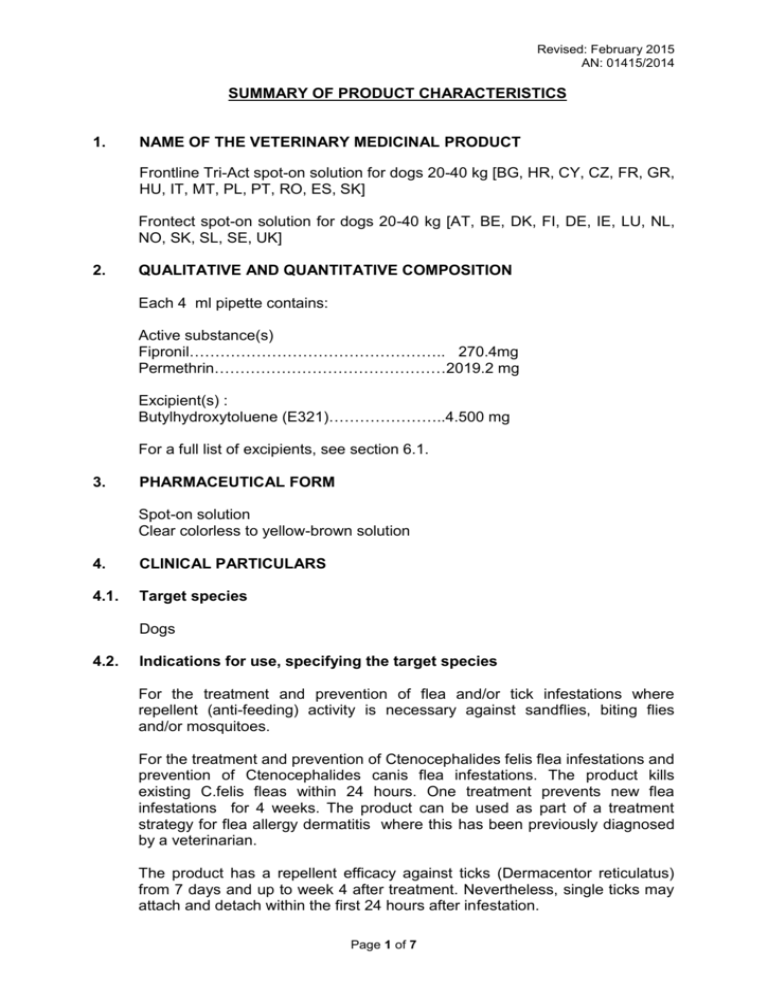
Revised: February 2015 AN: 01415/2014 SUMMARY OF PRODUCT CHARACTERISTICS 1. NAME OF THE VETERINARY MEDICINAL PRODUCT Frontline Tri-Act spot-on solution for dogs 20-40 kg [BG, HR, CY, CZ, FR, GR, HU, IT, MT, PL, PT, RO, ES, SK] Frontect spot-on solution for dogs 20-40 kg [AT, BE, DK, FI, DE, IE, LU, NL, NO, SK, SL, SE, UK] 2. QUALITATIVE AND QUANTITATIVE COMPOSITION Each 4 ml pipette contains: Active substance(s) Fipronil………………………………………….. 270.4mg Permethrin………………………………………2019.2 mg Excipient(s) : Butylhydroxytoluene (E321)…………………..4.500 mg For a full list of excipients, see section 6.1. 3. PHARMACEUTICAL FORM Spot-on solution Clear colorless to yellow-brown solution 4. CLINICAL PARTICULARS 4.1. Target species Dogs 4.2. Indications for use, specifying the target species For the treatment and prevention of flea and/or tick infestations where repellent (anti-feeding) activity is necessary against sandflies, biting flies and/or mosquitoes. For the treatment and prevention of Ctenocephalides felis flea infestations and prevention of Ctenocephalides canis flea infestations. The product kills existing C.felis fleas within 24 hours. One treatment prevents new flea infestations for 4 weeks. The product can be used as part of a treatment strategy for flea allergy dermatitis where this has been previously diagnosed by a veterinarian. The product has a repellent efficacy against ticks (Dermacentor reticulatus) from 7 days and up to week 4 after treatment. Nevertheless, single ticks may attach and detach within the first 24 hours after infestation. Page 1 of 7 Revised: February 2015 AN: 01415/2014 The product has immediate acaricidal efficacy against Rhipicephalus sanguineus and Ixodes ricinus, but if ticks are present when the product is applied, all ticks may not be killed within 48 hours after treatment. The product has persistent acaricidal efficacy against ticks (Ixodes ricinus, Dermacentor reticulatus, Rhipicephalus sanguineus) for 4 weeks. The product has a repellent efficacy (anti- feeding) for 3 weeks against sandflies (Phlebotomus perniciosus) and for 4 weeks against mosquitoes (Culex pipiens). The product has a persistent insecticidal efficacy for 3 weeks against sandflies (Phlebotomus perniciosus). The product repels and kills stable flies (Stomoxys calcitrans) for five weeks. 4.3. Contraindications Do not use on sick or convalescent animals. This product is for use on dogs only. Do not use in cats and rabbits, as adverse reactions and even death could occur. Do not use in case of known hypersensitivity to the active substances or to any of the excipients. (see also section 4.5(i) 4.4. Special warnings for each target species There may be an attachment of single ticks or bites by single mosquitoes or sandflies. For this reason, transmission of pathogens by these arthropods cannot be completely excluded if conditions are unfavorable. The product remains effective against fleas when treated animals are immersed in water occasionally (e.g., swimming, bathing). However, dogs should not be allowed to swim or be shampooed within 48 hours after treatment. Avoid frequent swimming or shampooing of treated dogs as this may adversely affect maintenance of product effectiveness. To reduce re-infestation from emergence of new fleas, it is recommended that all dogs in a household be treated. Other animals living in the same household should also be treated with a suitable product. To aid further in reducing environmental challenge, the additional use of a suitable environmental treatment against adult fleas and their developmental stages could be recommended. 4.5. Special precautions for use i. Special precautions for use in animals In the absence of specific studies, the use of the product is not recommended in dogs younger than 8 weeks of age, or in dogs weighing less than 2 kg. Care should be taken to avoid contact of the veterinary medicinal product with dog’s eyes. It is important to make sure that the product is applied to an area where the animal cannot lick it off and to make sure that other animals do not lick the treatment sites following application. Page 2 of 7 Revised: February 2015 AN: 01415/2014 Due to the unique physiology of cats which prevents them from metabolizing certain compounds, including permethrin, the product can induce potentially fatal convulsions in this species. In case of accidental dermal exposure, wash the cat with shampoo or soap, and seek veterinary advice rapidly. To prevent cats from being accidentally exposed to the product, keep treated dogs away from cats until the application site is dry. It is important to ensure that cats do not groom the site of application on a dog which has been treated with this product. In case of exposure of this type seek veterinary advice immediately. ii. Special precautions to be taken by the person administering the veterinary medicinal product to animals This product can cause skin and eye irritation, therefore, avoid contact of the product with skin and eyes. Do not open the pipette near or towards the face. In case of ocular exposure or if eyes become irritated during administration, immediately flush the eyes with plenty of water. If ocular irritation persists, seek medical attention. In case of dermal exposure or if skin becomes irritated during administration, immediately wash the skin with plenty of soap and water. If skin irritation persists or recurs, seek medical attention. People with known hypersensitivity to fipronil and/or permethrin should avoid contact with the product. The product is harmful if swallowed. Avoid hand-to-mouth contact. Do not smoke, drink or eat during application. Wash hands after use. If swallowed rinse mouth and seek medical attention if you feel unwell. Since the excipient N-methylpyrrolidone may induce foetotoxicity and teratogenicity after significant exposure, pregnant women should wear gloves to avoid contact with the product.Treated animals should not be handled until the application site is dry, and children should not be allowed to play with treated animals until the application site is dry. It is therefore recommended that animals are not treated during the day, but should be treated during the early evening, and that recently treated animals are not allowed to sleep with owners, especially children. Keep the stored pipettes in the original blister and once used, the empty pipette should immediately be disposed of in a proper way, preventing further access. iii. Other precaution The product may adversely affect aquatic organisms. Treated dogs should not be allowed to enter surface water for 2 days after treatment. 4.6. Adverse reactions (frequency and seriousness) Among the very rare suspected adverse reactions, transient skin reactions at the application site (skin discolouration, local hair loss, itching, redness) and general itching or hair loss have been reported after use. Excessive salivation, reversible nervous signs (increased sensitivity to stimulation, hyperactivity, muscle tremor, depression, other nervous signs) or vomiting have also been observed after use. Page 3 of 7 Revised: February 2015 AN: 01415/2014 If licking of the application site occurs, transient hypersalivation and emesis may be observed. 4.7. Use during pregnancy, lactation or lay Laboratory studies using fipronil or permethrin have not shown any evidence of teratogenic or embryotoxic effects. Studies have not been carried out with this product in pregnant and lactating animals (see 4.5(i)). N-methylpyrrolidone, an excipient in the veterinary medicinal product, has shown to be teratogenic in laboratory animals after repeated exposure at high doses. Use only according to the benefit/risk assessment by the responsible veterinarian. 4.8. Interaction with other medicinal products and other forms of interaction None known. 4.9. Amounts to be administered and administration route The recommended minimum dose is 6.76 mg fipronil/kg bodyweight, and 50.48 mg/kg permethrin equivalent to 0.1 ml spot-on solution per kg bodyweight. The use of the product should be based on a confirmed infestation or risk of infestation with fleas and/or ticks when repellent (anti-feeding) activity is also necessary against sand-flies and/or mosquitoes and/or biting flies. Depending on the ectoparasite challenge repetition of the treatment might be indicated. In such instances, the interval between two treatments should be at least 4 weeks. Method of administration: Select the appropriate pipette size for the weight of the dog. For dogs over 60 kg, use the appropriate combination of two pipette sizes that most closely matches the bodyweight. The product should be applied in two out-of-reach spots so that the dog cannot lick the application site. These sites are at the base of the neck in front of the shoulder blades and the middle of the neck between the base of the skull and the shoulder blades. Remove the blister card from the package and separate one blister. Remove the pipette by cutting along the dotted line with a pair of scissors or tearing open after folding the marked corner. Holding the pipette upright away from face and body, cut the pipette tip with scissors to open. Part the coat on the back of the dog until the skin is visible. Place the tip of the pipette on the skin. Squeeze the pipette, applying about half of the contents half way down the neck between the base of the skull and the shoulder blades. Repeat the application at the base of the neck in front of the shoulder blades to empty the pipette. For best results, ensure that the product is applied directly to the skin rather than on the hair. Page 4 of 7 Revised: February 2015 AN: 01415/2014 4.10. Overdose (symptoms, emergency procedures, antidotes), if necessary Safety has been assessed with up to 5 times the maximum dose in healthy adult dogs (treated up to 3 times at monthly intervals) and in puppies (aged 8 weeks treated once). Known side-effects may consist of mild neurological signs, emesis and diarrhea. These are transitory and generally resolve without treatment within 1-2 days. The risk of experiencing adverse reactions (see section 4.6) may increase with overdosing, so animals should always be treated with the correct pipette size according to bodyweight. 4.11 Withdrawal period Not applicable 5. PHARMACOLOGICAL PROPERTIES Pharmacotherapeutic group: Ectoparasiticides for topical use, ATCvet code: QP53AX65 (fipronil, combination). 5.1. Pharmacodynamic properties Fipronil is an insecticide and acaricide belonging to the phenylpyrazole family. Fipronil and its metabolite fipronil sulfone act at ligand-gated chloride channels, in particular those gated by the neurotransmitter gammaaminobutyric acid (GABA) as well as desensitising (D) and non-desensitising (N) channels gated by glutamate (Glu, unique invertebrate ligand-gated chloride channels), thereby blocking pre- and post-synaptic transfer of chloride ions across cell membranes. This results in uncontrolled activity of the central nervous system and death of arthropods. Fipronil kills fleas within 24 hours, ticks and lice within 48 hours post-exposure. Permethrin belongs to the Type I class of pyrethroids, which are acaricides and insecticides with repellent activity. Pyrethroids affect the voltage-gated sodium channels in vertebrates and non-vertebrates. Pyrethroids are socalled “open channel blockers” affecting the sodium channel by slowing both the activation and the inactivation properties, thus leading to hyper-excitability and death of the parasite. Permethrin in the product provides repellent activity against sandflies (> 80% for 4 weeks), mosquitoes and ticks.. 5.2. Pharmacokinetic particulars The pharmacokinetic profiles of fipronil and permethrin in combination were studied after topical application in dogs by measuring plasma and hair concentrations for 58 days following treatment. Both permethrin and fipronil, together with its major metabolite, fipronil sulfone, are well- distributed on the haircoat of a dog during the first day after application. The concentrations of fipronil, fipronil sulfone and permethrin in the hair coat decrease with time and are detectable for at least 58 days after dosing. Fipronil and permethrin act topically upon contact with external parasites and the low systemic absorption of fipronil and permethrin is not relevant for the clinical efficacy. Page 5 of 7 Revised: February 2015 AN: 01415/2014 The spot-on application resulted in negligible systemic absorption of permethrin with sporadic measureable concentrations of cis-permethrin between 11.4 ng/mL and 33.9 ng/mL observed 5 to 48 hours following treatment. Mean maximum plasma concentrations (Cmax) of 30.1 ± 10.3 ng/ml fipronil and 58.5 ± 20.7 ng/ml of fipronil sulfone were observed between Day 2 and 5 (Tmax) following application. Fipronil plasma concentrations then decline with a mean terminal half-life of 4.8 ± 1.4 days. 6. PHARMACEUTICAL PARTICULARS 6.1. List of excipients N-methylpyrrolidone Butylhydroxytoluene (E321) Medium-chain triglycerides 6.2. Incompatibilities None known 6.3. Shelf life Shelf life of the product as packaged for sale: 30 months. 6.4. Special precautions for storage Store in the original blister. Do not store above 25°C. 6.5. Nature and composition of immediate packaging The primary packaging is a heat-formed film of polyethylene-ethylvinyl alcohol-polyethylene/polypropylene. The secondary packaging consists of a plastic/aluminium blister with a plastic/aluminium backing. Plastic card of 1 pipette containing 4 ml. Carton box of 3 or 6 pipettes containing 4 ml each. One size only per box. Not all pack sizes may be marketed. 6.6. Special precautions for the disposal of unused veterinary medicinal products or waste materials derived from the use of such products Any unused veterinary medicinal product or waste material derived from such veterinary medicinal product should be disposed of in accordance with local requirements. The product may adversely affect aquatic organisms. Do not contaminate ponds, waterways or ditches with the product or empty container. Page 6 of 7 Revised: February 2015 AN: 01415/2014 7. MARKETING AUTHORISATION HOLDER Merial Animal Health Ltd PO Box 327 Sandringham House Harlow Business Park Harlow Essex CM19 5TG 8. MARKETING AUTHORISATION NUMBER Vm 08327/4261 9. DATE OF FIRST AUTHORISATION Date: 16 October 2014 10. DATE OF REVISION OF THE TEXT Date: February 2015 Approved: 10 March 2015 Page 7 of 7
